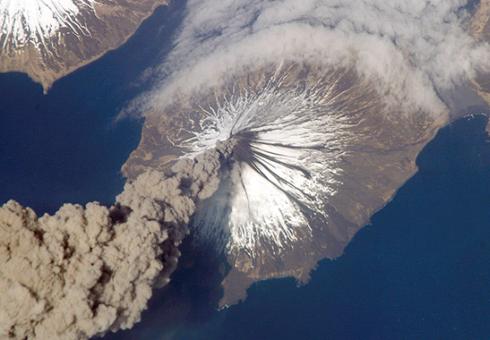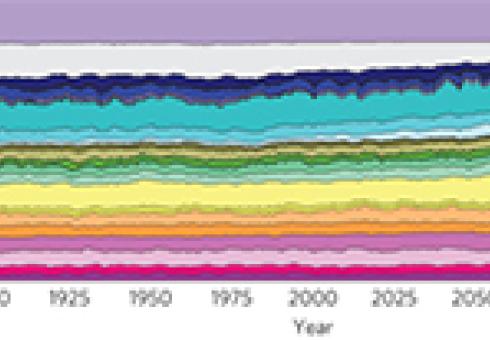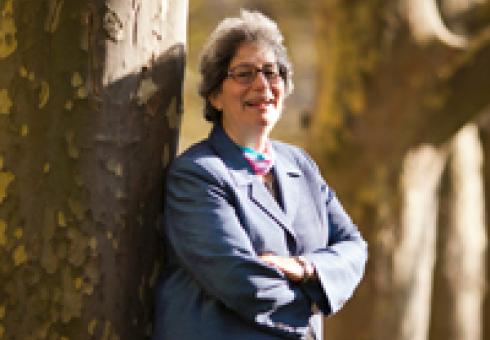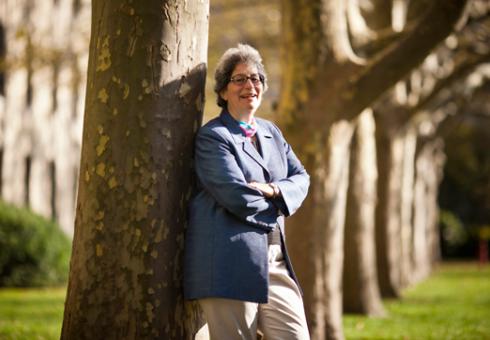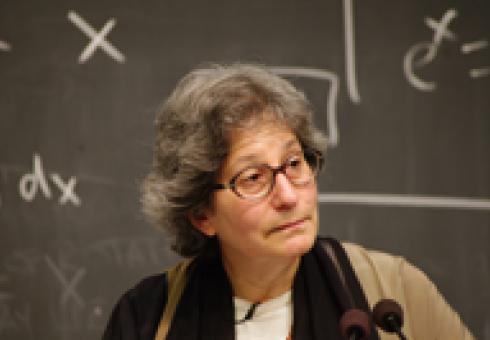Alli Gold Roberts
MIT Joint Program on the Science and Policy of Global Change
By the late 1990s, scientists had observed more than two decades of rapid global warming, and expected the warming trend to continue. Instead, despite continuing increases in greenhouse gas emissions, the Earth’s surface temperatures have remained nearly flat for the last 15 years. The International Panel on Climate Change verified this recent warming “hiatus” in its latest report.
Researchers around the globe have been working to understand this puzzle—looking at heat going into the oceans, changes in wind patterns, and other factors to explain why temperatures have stayed nearly stable, while greenhouse gas concentrations have continued to rise. In a study published today in Nature Geoscience, a team of scientists from MIT and elsewhere around the U.S. report that volcanic eruptions have contributed to this recent cooling, and that most climate models have not accurately accounted for the effects of volcanic activity.
“This is the most comprehensive observational evaluation of the role of volcanic activity on climate in the early part of the 21st century,” says co-author Susan Solomon, the Ellen Swallow Richards Professor of Atmospheric Chemistry and Climate Science at MIT. “We assess the contributions of volcanoes on temperatures in the troposphere—the lowest layer of the atmosphere—and find they’ve certainly played some role in keeping the Earth cooler.” 
There are many components of the Earth’s climate system that can increase or decrease the temperature of the globe. For example, while greenhouse gases cause warming, some types of small particles, known as aerosols, cause cooling. When volcanoes erupt explosively enough, they enhance these aerosols—a phenomenon referred to as “volcanic forcing.”
“The recent slowdown in observed surface and tropospheric warming is a fascinating detective story,” says Ben Santer, the lead author of the study and a climate scientist at Lawrence Livermore National Laboratory. “There is not a single culprit, as some scientists have claimed. Multiple factors are implicated. The real scientific challenge is to obtain hard quantitative estimates of the contributions of each of these factors to the so-called slowdown.”
The researchers verified the cooling phenomenon by performing two different statistical tests to determine whether recent volcanic eruptions have cooling effects that can be distinguished from the intrinsic variability of the climate. The team found evidence for significant correlations between volcanic aerosol observations and satellite-based estimates of both tropospheric temperature and sunlight reflected by the particles off the top of the atmosphere.
“What’s exciting in this work was that we could detect the influence of the volcanic aerosols in new ways. Using satellite observations confirmed the fact that the volcanic particles reflected a significant amount of the sun’s energy out to space, and of course losing energy means cooling—and the tropospheric temperatures show that too,” explains Solomon, who is also a researcher with MIT’s Joint Program on the Science and Policy of Global Change. “There are still uncertainties in exactly how big the effects are, so there is more work to do.”
Alan Robock, a professor of environmental sciences at Rutgers University and a leading expert on the impacts of volcanic eruptions on climate, says these findings are an important part of the larger climate picture. “This paper reminds us that there are multiple causes of climate change, both natural and anthropogenic, and that we need to consider all of them when interpreting past climate and predicting future climate.”
“Since none of the standard scenarios for evaluating future global warming include volcanic eruptions,” Robock adds, “this paper will help us quantify the impacts of future large and small eruptions when they happen, and thus better interpret the role of humans in causing climate change.”
This research was led by a team at Lawrence Livermore National Laboratory and builds upon work Solomon conducted in 2011, finding that aerosols in an upper layer of the atmosphere—the stratosphere—are persistently variable and must be included in climate models to accurately depict climate changes.
The research was supported by the U.S. Department of Energy.
News and Outreach: Susan Solomon
By Michael Craig, Amanda Giang, Colin Thackray 

What’s the difference between climate change, the Northern spotted owl, and acid rain?
That question is not the beginning of a bad joke. Rather, it was the type of question that lay at the heart of the class ‘Science, Politics, and Environmental Policy’ offered this past fall at the Massachusetts Institute of Technology. For the first time, the class was co-taught by Professors Susan Solomon of Earth, Atmospheric and Planetary Sciences and Judy Layzer of Urban Studies and Planning – an interdisciplinary team that drew students from diverse backgrounds across MIT’s schools and departments. Through weekly case studies, the class aimed to better understand how the United States has dealt with environmental problems and the multifaceted role of science in that process.
Each week, students focused on a different environmental issue, ranging from historical examples like the use of lead in gasoline, to currently unfolding debates, like the environmental impacts of unconventional shale gas production. Through reading, writing, and discussion, students explored how and why these issues entered the policy agenda (or didn’t), evolving policy responses, and how science fit into the picture. While fast and hard conclusions were elusive, as the class drew to a close students reflected on several themes that emerged over the course of the semester: the complexity of the policy-making process, the convoluted path that science takes from its origin to its use in policy, and the importance of storytelling for communicating science effectively.
Opening the black box of policy-making
Many of us initially saw the policy process as a black box – we could see the inputs (mainly science) and outputs (environmental policy), but did not fully grasp how one led to the other. Over the course of the semester, we came to a far better understanding of what levers exist to influence the policy-making process.
Some of those levers are litigation, direct involvement in the political process, and communication to the public. Each can influence the conversion of inputs to outputs, but vary in effectiveness under different circumstances. In part, such circumstances emerge from existing economic and political institutions, which can constrain policymaking and create path dependency. Recognizing these realities through case studies demonstrated the importance of looking at policy issues from different angles and thinking carefully about the best strategy for effecting change.
The path from science to policy
As we peeled the lid off the black box of policymaking, we also began to recognize how convoluted the path science travels from generation to use in policymaking can be. Science does not pass directly from academics to policymakers, but rather is filtered and translated by many individuals. These individuals – and even scientists themselves – have differing values, biases, and goals that can lead them to different interpretations of, and conclusions from, science. What role, if any, should scientists play along science’s path from lab to policy? Do scientists who act as advocates harm the credibility of science as a whole, and if so, does this harm outweigh the potential benefits? For scientists who act as the ‘experts’ that communicate the scientific basis of environmental issues to non-scientists, how do their biases and values shape their actions and their interpretation of science? If science is being filtered and reinterpreted, how can we ensure the veracity of information we receive that is purportedly "based on science”?
Stories matter
Over the course of the semester, the importance of storytelling also emerged as a major theme. In many of the cases we studied, public engagement was a key driver for policy action, so effectively communicating with and reaching the public is crucial. Doing so requires the ability to tell a clear story – to communicate information (scientific or otherwise) clearly, concisely, and in a way that is relevant to the audience. Focusing on what you know can help in putting forth a clear narrative, and while uncertainties are important to convey, they do not need to be the focus of communication.
There is no easy formula for developing strong environmental policies, nor are there simple rules for how science should be involved. That said, 'Science, Politics, and Environmental Policy' helped us develop a more nuanced understanding of the complex policy-making process, and gave us tools to engage in it strategically, and with self-awareness. Rarely is there an opportunity to discuss the many-layered environmental policy system with students with such diverse expertise. The confluence of ideas and points of view from the varied backgrounds of both the students and professors resulted in a unique learning experience for this collection of young environmental scholars.
Colin Thackray is a graduate student in MIT's Department of Earth, Atmospheric and Planetary Sciences working with Noelle Selin. Amanda Giang and Michael Craig are graduate students in MIT's Engineering Systems Division.

"The warmer climate gets, the faster the climate zones are shifting. This could make it harder for plants and animals to adjust," said lead author Irina Mahlstein.
The study is the first to look at the accelerating pace of the shifting of climate zones, which are areas of the Earth defined by annual and seasonal cycles of temperature and precipitation, as well as temperature and precipitation thresholds of plant species. Over 30 different climate zones are found on Earth; examples include the equatorial monsoonal zone, the polar tundra zone, and cold arid desert zone.
"A shift in the climate zone is probably a better measure of 'reality' for living systems, more so than changing temperature by a degree or precipitation by a centimeter," said Mahlstein.
The scientists used climate model simulations and a well-known ecosystem classification scheme to look at the shifts between climate zones over a two-century period, 1900 to 2098. The team found that for the initial 2 ° Celsius (3.6 ° Fahrenheit) of warming, about 5 percent of Earth's land area shifts to a new climate zone. The models show that the pace of change quickens for the next 2 ° Celsius of warming, and an additional 10 percent of the land area shifts to a new climate zone. "Pace of shifts in climate regions increases with global temperature" was published online in the journal Nature Climate Change on April 21.
Certain regions of the globe, such as northern middle and high latitudes, will undergo more changes than other regions, such as the tropics, the scientists found. In the tropics, mountainous regions will experience bigger changes than their surrounding low-altitude areas.
In the coming century, the findings suggest that frost climates–the coldest climate zone of the planet–are largely decreasing. Generally, dry regions in different areas of the globe are increasing, and a large fraction of land area is changing from cool summers to hot summers.
The scientists also investigated whether temperature or precipitation made the greater impact on how much of the land area changed zones. "We found that temperature is the main factor, at least through the end of this century," said Mahlstein.
This story is adapted from a news article at esrl.noaa.gov.
Susan Solomon has won both the Vetlesen Prize and a 2012 BBVA Foundation Frontiers of Knowledge Award.
The Vetlesen Prize is given “for scientific achievement resulting in a clearer understanding of the Earth, its history, or its relations to the universe” and is designed to recognize sweeping achievements on par with the Nobel. The Prize was established in 1959 and is given every several years by a selection committee appointed by the president of Columbia University. The most recent award was in 2008 to geologist Walter Alvarez. Previous winners include climate scientists Sir Nicholas Shackleton and Wallace Broecker, marine geologist Walter Pitman, seismologist Lynn Sykes, and founding director of Lamont Maurice “Doc” Ewing.
Soloman is being recognized for her work in identifying the cause of the Antarctic ozone hole. This research helped bring about a global ban on manmade ozone-depleting chemicals. She shares the award with French climate scientist Jean Jouzel who is being recognized for his work extracting the longest-yet climate record from polar ice cores. The pair will receive the award and accompanying medal at Columbia's Low Library on Thursday, February 21st.
The BBVA Foundation Frontiers of Knowledge Awards recognize, among other things, outstanding contributions that advance understanding or deliver material progress with regard to climate change, one of the key challenges of the global society of the 21st century.
The award citation states that Solomon "has contributed, through her research and leadership, to the safeguarding of our planet." Solomon's work over 30 years has succeeded in establishing and drawing together links between three key climate change variables: human activity, a profound and comprehensive understanding of the behavior of atmospheric gases, and the alteration of climate patterns globally.
Atmospheric science pioneer Susan Solomon speaks on past environmental accomplishments, technology’s role and how history should be our guide to meeting today’s global challenges.
By: Vicki Ekstrom Few can speak with as much authority on the topic of environmental success as Susan Solomon.
Few can speak with as much authority on the topic of environmental success as Susan Solomon.
An MIT professor of atmospheric chemistry and climate science, Solomon was the first to identify the chemical process that causes the ozone hole, and she made some of the first measurements in Antarctica demonstrating that chlorine-containing chemicals that used to be in refrigerators and spray cans are the cause of ozone depletion.
In a Sept. 13 talk, Solomon used the phasing out of these chemicals, known as chlorofluorocarbons (CFCs), as well as the phasing out of lead in indoor paint and gasoline, as successful examples from which the world could learn how to meet today's most critical global challenge: climate change.
VIDEO: Watch the event
CFCs and lead were phased out mainly because of the clear evidence of their danger and strong public understanding of personal health impacts, explained Solomon, who came to MIT last year from the U.S. National Oceanic and Atmospheric Administration and the University of Colorado.
In the case of CFCs, the real reason they were able to be phased out "was because of us," Solomon said.
"Most of these CFCs came from spray cans everyone was using for hairspray and deodorant, so one of the primary sources was literally in your medicine cabinet at home."
When two chemists found that CFCs might deplete the ozone layer and increase risks of skin cancer, "that was enough to get people concerned … [and] it wasn't that difficult to make the change. All you had to do was 'get on the stick,'" Solomon said, parodying a well-known advertisement from that era.
"The key thing that this did was take something that had been very good business and turn it into bad business," Solomon said. To meet the shifting consumer demand, "technological successes were achieved in sector after sector where chlorofluorocarbons were used." Public understanding and action spurred the technological advancements that paved the way to success. But gaining that broad public support isn't always easy.
Public understanding and action spurred the technological advancements that paved the way to success. But gaining that broad public support isn't always easy.
In the case of lead, the trail of scientific evidence warning of health impacts went back as far as the Roman Empire, and perhaps even further. Yet it took many centuries before real action was taken.
"One of the reasons we were slow in doing something about lead was because of scientists who were skeptics," Solomon said, displaying a clear parallel to the climate change issue.
In the end, it was civil rights that spurred public engagement, as poor African American children living in deteriorating housing and near highways were found to have higher levels of lead in their blood, Solomon said.
Solomon also pointed out that the developed world had the infrastructure and institutions to make these changes possible.
"It's easy to knock the EPA these days, but the EPA, FDA, Consumer Product Safety Commission, those are all organizations that we have to thank."
Today's environmental challenge: climate change
Many of the underlying health and human rights concerns from the past are alive today, as the world confronts climate change.
The ethical dimension is especially disturbing, and it's making the problem even more complex and difficult to address. Solomon explained that the average person in the developed world emits a 1,000 times more emissions than the average person in Chad, 200 times more than those in Ethiopia, 80 times more than those in Kenya, and 20 times more than those in India.
"Six billion live in the developing world and they emit about five times less CO2 per person than the one billion of us in the developed world," Solomon said.
At the same time, those countries want to grow and develop. If they choose to grow using fossil fuels like the developed world, global emissions will go up significantly.
"So the key question, the key sustainability issue is, what about those peoples' future?" she said. "Should China pay more to develop than we did? Should Africa?
Such questions aren't sparking the same level of public engagement the world saw before phasing out lead and CFCs, but Solomon thinks they should. "We're in the developed world, we have air conditioning, we have comfortable lives, we have to think beyond us."
"We're in the developed world, we have air conditioning, we have comfortable lives, we have to think beyond us."
While Solomon notes that she personally takes the bus and does what she can to reduce the amount she emits, she's not fooling herself into believing that such actions from everyone will be enough.
"This issue will not be solved by giving up your spray deodorant, this issue won't be solved by taking the bus," Solomon says. "The problem is much bigger."
With no one silver bullet on the horizon, Solomon says research on many different approaches is critical. That could include research on reducing deforestation, increasing wind and solar power, using more efficient cars and building techniques, expanding nuclear, gas and biofuel energy, or employing carbon capture and storage techniques.
To gain this fundamental research and development will require a "bottoms-up technology policy where we start as consumers saying we need a space race for energy technology," Solomon says. "That's what I think we need because engineering and technology has to pave the way. That's why I'm at MIT."

